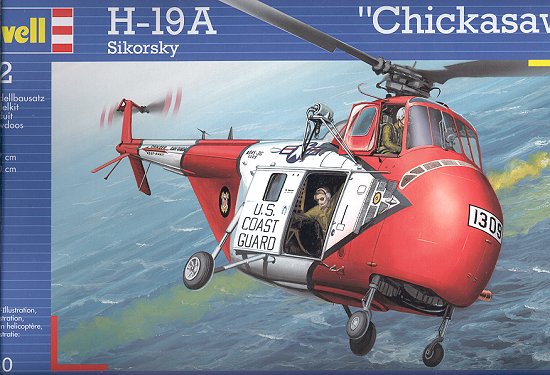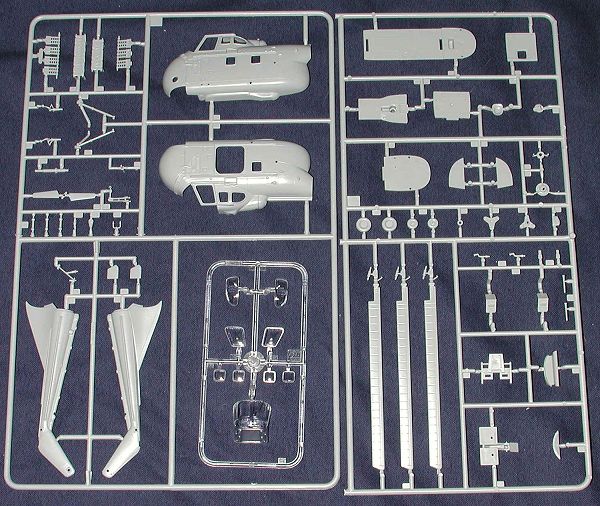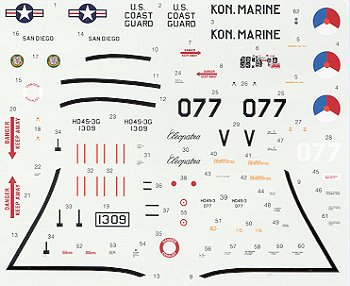
|
KIT: |
Revell 1/72 H-19A 'Chickasaw' |
|
KIT # |
4460 |
|
PRICE: |
$19.95 |
|
DECALS: |
Two aircraft |
|
REVIEWER: |
|
|
NOTES: |
Rebox of the Italeri kit with different decals. |

|
HISTORY |
It is interesting that the first really successful helos in several categories were Sikorsky designs. Yet today, when one thinks of helicopters 'Bell' generally springs to mind. This is one of those really successful Sikorsky designs. The first truly capable transport helo. Despite being generally underpowered, the H-19 was able to carry a useful load, all safely held within the confines of a cabin, so you didn't have to be hanging in the breeze.
Designed in the late 1940s for the Army, it found a great deal of use with the USAF, Navy and Marines. It is probably the Air Force that most people relate with the H-19 as it was a common site as what is now call SAR, but was then just referred to has Rescue. These yellow banded helos were at most bases and used in a variety of missions.
In service in time to see action in Korea, the H-19 was a real workhorse in the years following the war. Relatively simple to maintain and rugged, it saw lots of action with forces of other countries and was still around when the Vietnam War started to heat up. To my knowledge, none are currently flying, but you can see them in museums around the world.
|
THE KIT |

Those of you with sharp eyes and even sharper memories will be saying 'Hey, this is the sprue from the Italeri kit you reviewed a bit back'. Yes, I decided not to break into the shrink on the Revell kit. Several reasons. One is that the Revell kit is molded in white, which is a real pain to photograph. Secondly, there is little difference between the two kits. The only thing that is different is the tail boom. Specifically this version has the smaller vertical tail, straight boom, and larger stabilizing fins with a smaller tail skid.
(Late addition: Apparently some folks did not understand the above paragraph. The image above is of the H-19B kit and not the H-19A being previewed. I did not want to open the shrink on this kit as they were so similar. I'll restate that the only difference between the two boxings is the tail boom. On the A has the drooped ventral strakes, is straight, vice slightly 'bent', and has a thinner fin. Neither this kit nor the other one previewed had floats.)
 Everything I said in the
previous review is the same, but for the decals, so
I'll concentrate on those for the remainder of this preview. Basically you get
two very different markings on this one. The box art markings are for a white
and Day-glo version from the US Coast Guard. It is bound to be a real beauty
when done, though it will take some careful masking to get the paint and stripes
to properly match up. Though the booms won't be a problem, the fuselage striping
will require extra care in applying. The other option is for a Dutch Navy
version. It is equally colorful in Sea Grey uppers and Sky lower surfaces. In
fact, there are a huge number of other possible markings options for this and
the other kit if someone would only commit to a decal sheet or two on it.
Unfortunately, helo decal sheets just don't sell that well as most makers will
look to fast jets and other subjects before having the foresight to tackle the
whirlybirds. The Revell sheet is typical of what they produce in that it is
matte and will probably stick very well once applied.
Everything I said in the
previous review is the same, but for the decals, so
I'll concentrate on those for the remainder of this preview. Basically you get
two very different markings on this one. The box art markings are for a white
and Day-glo version from the US Coast Guard. It is bound to be a real beauty
when done, though it will take some careful masking to get the paint and stripes
to properly match up. Though the booms won't be a problem, the fuselage striping
will require extra care in applying. The other option is for a Dutch Navy
version. It is equally colorful in Sea Grey uppers and Sky lower surfaces. In
fact, there are a huge number of other possible markings options for this and
the other kit if someone would only commit to a decal sheet or two on it.
Unfortunately, helo decal sheets just don't sell that well as most makers will
look to fast jets and other subjects before having the foresight to tackle the
whirlybirds. The Revell sheet is typical of what they produce in that it is
matte and will probably stick very well once applied.
|
CONCLUSIONS |
Probably the big question is: should I buy this kit or the
Italeri boxing of the H-19A? The plastic is exactly the same in both of them;
the only difference being instructions and the decal options. It is also
possible that the Italeri kit is difficult to find. One thing for sure, the
Revell AG kit is the more expensive of the two! Review kit courtesy of my kit collection. Here is a late piece of information by Tony Hodun:
“The H-19/S-55
helicopters fall into two visual families, with two different tail boom designs.
The earliest design was the horizontal tail boom with two downward angled tail
surfaces (the tail surfaces sometimes are absent). The later design has a
downward swept tail boom with two smaller horizontal tail surfaces; the upswept
tail rotor part of the boom is wider in chord. There is no definitive book on
the H-19/S-55 (yet), so what follows is the current results of my research in
references and on the internet (subject to future revision if more or better
data surfaces!). The earlier tail boom appears to have been found on USAF
H-19As, US Army H-19Cs, and all US Navy, Marine, and Coast Guard HO4S/HRS/H-19
airframes regardless of engine type. The later tail boom appears to have been
found on USAF H-19Bs and US Army H-19Cs. H-19s/S-55s operated by other air
forces of the world and by civil operators can be found with either type of tail
boom (e.g., the French Air Force operated both styles). Some H-19/S-55s were
later converted to the later style tail boom.
The good news is
that Italeri did their homework and has provided us with kits to build either
version. Use the Italeri H-19A Rescue or Revell Germany H-19A kits for the
early tail boom, and the Italeri H-19B for the later tail boom. The Italeri
H-19A also includes amphibious floats, and can be built with wheels only as
well; those floats will fit the H-19B fine, too. In all cases, use your
references, find a photo of the bird you are building if you can. If anyone has
more information on these helos, please let me or Scott know!” If you would like your product reviewed fairly and quickly by a
site that has well over 100,000 visitors a month, please contact
me or see other details in the Note to
Contributors.